KUMANO TRAIL
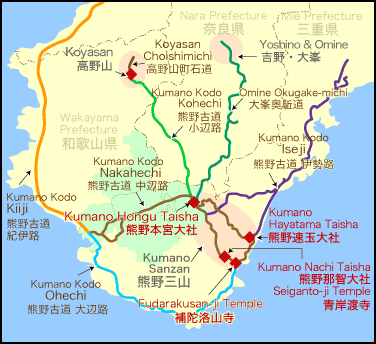
Kii Peninsula with
the Kumano Trail The Kumano Trail (southeast of Nara) is route that was used by pilgrims traveling from Kyoto and Ise to the famous shrines on the Kii Peninsula. The mountains and the forest of this region were traditionally the stomping ground of “yamabushi”, mountain ascetics who are members of Esoteric Shingon and Tendai sects of Buddhism.
Here you can get into hiking as a spiritual experience and follow in the footsteps of ancient pilgrims on the sacred trails of the Kii Peninsula. The trails are known for its damp green forests with giant cryptomeria and fir trees, moss-covered stones, swirling mists, odd-shaped rocks, jagged peaks, and temples associated with nature spirits. There isn't much wildlife along the route. Occasionally hikers see monkeys. The hiking itself is not unlike that of the Appalachian Trail in the U.S.
The destinations of Kumano Trail are three major shrines of Kumano Sect in the southern Kii peninsula: Kumano Hongu Taisha, Kumano Nachi Taisha and Kumano Hayatama Taisha. The Kumano sect emphasize nature worship and worships 12 primary god. At Kumano Nachi Taisha, an additional god associated with a nearby waterfall is worshiped. The Kumano area is believed to be the place where the Izanami, the creator of the Japanese islands, entered the World of Death and was reborn.
Most of the trails pass through remote wilderness area far from roads. Huts, where people can sleep using their own sleeping bags, are spaced at regular intervals. Periodically the trail passes through towns, villages and settlement, where food can purchased and guesthouses welcome hikers. Be prepared for wet weather. The mountains through which the trails pass receive a lot of rain. Websites: Japan Guide japan-guide.com ; Kumano Kodo tb-kumano.jp ; JNTO article japan-magazine.jnto.go.jp; Hongu Kumano Kodo hongu.jp ; Kumano Kodo Ise Route kumadoco.ne ; UNESCO World Heritage site: UNESCO website
History of the Kumano Trail
Pilgrimages to the Kumano shrines became very popular in the 10th century among the aristocracy, with members of Imperial family sometimes taking part. One emperor made the trek 33 times, each time accompanied by an entourage of 1,000 retainers. In the 14th and 15th centuries the routes became popular with ordinary people. At one time so many participated on the journey it was called the "pilgrimage of ants."
Many embarked on the a visit to the shrines in the belief that miraculous powers attributed to the Kumano sect would be passed on to them. The 370-kilometer route from Kyoto to Kumano Hongu Taisha was the most popular route. It took about a month to traverse. Reaching the other two shrines took longer.
The original route traveled from Kyoto to Osaka, where there 99 important small shrines were located, and then continued eastward to the Kumano region. In 2004, the Kumano Sanzen area was named a UNESCO World Heritage Site. Typhoon No. 12 in September 2011 damaged some of the Sacred Sites and Pilgrimage Routes in the Kii Mountain Range. Huge landslides occurred on the Kumano Kodo, and there was also damage to the Kumano Sanzan shrines. It may take several years to restore the areas to their original state. According to the Wakayama Prefecture Board of Education, nearly 100 meters of the Kumano Kodo collapsed about one kilometer east of Mikoshi Pass in Tanabe, Wakayama Prefecture.
Kii Mountain Sacred Sites and Pilgrimage Routes: UNESCO World Heritage Site
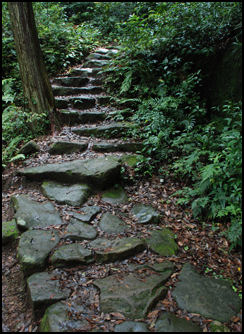
Kii Peninsula embraces Wakayama, Mie, and much of Nara prefectures. It is the home of Mt. Koya, Yoshino, the Kuramo pilgrimage trail, Ise shrine and the hot springs of central Wakayama.
Sacred Sites and Pilgrimage Routes in the Kii Mountain Range Nara, Mie, Wakayama prefecture were declared a UNESCO World Heritage Site in 2004 According to UNESCO: “Set in the dense forests of the Kii Mountains on a peninsula in the southernmost part of mainland Japan, overlooking the Pacific Ocean, three sacred sites – Yoshino and Omine, Kumano Sanzan, and Koyasan – are linked by pilgrimage routes to the ancient capital cities of Nara and Kyoto. Together these sites, the connecting pilgrimage routes, and surrounding forests form a cultural landscape that reflect the fusion of Shintoism, rooted in the ancient tradition of nature worship in Japan, and Buddhism, which was introduced from China and the Korean Peninsula. [Source: UNESCO]
“The sacred sites are connected by 307 kilometers of pilgrimage routes which cover a total area of 506.4 ha. With the surrounding forest landscape, they reflect a persistent and extraordinarily well-documented tradition of sacred mountains maintained over 1,200 years. The area, with its abundance of streams, rivers and waterfalls, is still part of the living culture of Japan and is much visited for ritual purposes and hiking, with up to 15 million visitors annually. Each of the three sites contains shrines, some of which were founded as early as the 9th century.”
The site is important because: “1) The monuments and sites that form the cultural landscape of the Kii Mountains are a unique fusion between Shintoism and Buddhism that illustrates the interchange and development of religious cultures in East Asia. 2) The Shinto shrines and Buddhist temples in the Kii Mountains, and their associated rituals, bear exceptional testimony to the development of Japan’s religious culture over more than a thousand years. 3) The Kii Mountains have become the setting for the creation of unique forms of shrine and temple buildings which have had a profound influence on the building of temples and shrines elsewhere in Japan. 4) Together, the sites and the forest landscape of the Kii Mountains reflect a persistent and extraordinarily well-documented tradition of sacred mountains over the past 1,200 years.”
“The property consists of three sacred sites including precincts and buildings of temples and shrines in the heavily forested Kii Mountains, and a complex pattern of tracks and paths that link the sites together. These component parts are essential for demonstrating the religious framework of Shintoism (rooted in the ancient tradition of nature worship in Japan), Buddhism (introduced to Japan from China and the Korean Peninsula), and Shugen-dô (the Shugen sect) which was influenced by the former two faiths. The three sacred sites with their surroundings demonstrate high degree of integrity. Also the pilgrimage routes, as part of the extensive cultural landscape, at present retain a significant degree of integrity.”
Kumano Trail Routes and Major Shrines
The Kumano Trail is actually a spiderweb of trails and routes through Nara, Wakayama and Mie Prefectures. Three pilgrimage routes: 1) Omine Okugakemichi to Yoshino-Omine, which splits into three narrower paths, the Kohechi, Nakahechi and Ohechi trails; 2) Kumano Sankeimichi to Kumano Sanzan — a holy place with three shrines: Kumano Hongu Grand Shrine, Kumano Hayatama Grand Shrine and Kumano Nachi Grand Shrine; and 3) Koyasan Choishimichi to Koyasan — and sacred sites found along them in the Kii Peninsula were listed as UNESCO World Heritage Sites in 2004.
Among the other routes There is also 4) the Iseji Route routes between Ise and Kumano Hayatama Grand Shrine; 5) the Hongodo route to Kumano Hongu Grand Shrine; 6) the Obechi route along the coastline to the Nachi Districti in Nachikatsuuracho via the Kii Peninsula; and 7) the Nakahechi route between Tanabe and Nachikatsiuracho.

19th century pilgrims Kumano-Hongu Taisha Shrine was previously located on a sandbank of the Kumano River was transferred to the current location after heavy floods occurred during the Meiji era. From here, visitors can follow the pilgrimage road on the river leading to the Kumano-Hayatama Taisha Shrine by a riverboat.
Kumano-Hayadama Taisha Shrine is situated at the mouth of Kumano River. There is a footpath leading from towering Mt. Chihogamine behind the shrine to the Kamikura-jinja Shrine (main shrine), a place where an enshrined deity is said to be descended for the first time.
Kumano Hongu Spa Village is part of the UNESCO World Heritage Site. The periphery of Kumano-Hongu Taisha Shrine has been traditionally known as a spa area. The Kawayu Onsen Resort, Yunomine Onsen Resort, and Watarase Onsen Resort exhibit townscapes with a nostalgic feel.
Kumano-Nachi Taisha Shrine is situated next to Nachino-Otaki Falls, Japan's tallest waterfall. The evergreen forests protected as the Nachi primeval forest spread behind the falls.
Some sections of the route are a little scary. The trail over 1,780-meter-high Daifugen-dake utilizes ladders and bridges to skirt cliffs and bypass rock outcroppings. The route along 1546-meter-high Gyoja-gaeri-dake has excellent views when the weather is clear. Women are prohibited from entering some places.
On top of 1850-meter Mt. Misen, the second highest mountain in the area, is a cluster of huts where hikers can sleep. Near the hut at the Misen River there is a good swimming hole. From here there are two trails to the pleasant town of Kawai. Don't take the ones that goes by the river. Another trail leads to the hot spring and shrine at Tenkawa. There is bus between Kawai and Shimoichi station. Website: Nara Prefecture tourism site Visit Nara
Yoshino Area Yamabushi
The Yoshino area, near Nara and Osaka, was a major yamabushi stronghold. The Kii mountain range here encompasses several peaks over 1,500 meters and stretches across the Kii Peninsula into the Yoshino area. Since ancient times, the mountains have been worshiped as a sacred place and have been the site of numerous shugendo ascetics’ practice.
Masahira Ueno wrote in Yomiuri Shimbun: Deep in the Kii mountain range, the sounds of horagai triton shell horns echo around Sho no Iwaya, a cave where mountain ascetics are said to have once spent the winters during their mountain-dwelling shugendo practice to develop their spiritual experience and power. Kumano Shugen, a group of about 30 mountain ascetics based at Seigantoji temple in the Kumano district of Wakayama Prefecture, visit the cave every December as the conclusion of that year’s shugendo practice. [Source: Masahira Ueno, Yomiuri Shimbun, January 28, 2014]
In the old days, yamabushi had to walk the 24 kilometer distance between Tenkawamaru and 1,719-meter-high Mt. Sanjodadake everyday for 100 days. During the first 50 days they were given two days to make the round trip During the second 50 days they had to the round trip trek in a single day, stopping at more than 20 small hokora shines along the route to chant sutras.
See Yamabushi Rituals Under YAMABUSHI, SHUGENDO AND MOUNTAIN ASCETICISM IN JAPAN factsanddetails.com
Mt. Omine

Mt. Omine (Kumano Trail near Yoshino, accessible from the town of Dorokawa) is sacred peak where it is said the diamond and womb mandalas become one. At the top of the mountain is a temple used for Shugendo Buddhist sect. The temple consists of five large buildings and several smaller buildings. It has nine mountain huts, where visitors cans sleep.
Mt. Omine is 1,719 meters (5,640 feet) high. Pilgrims have been climbing the mountain since the 9th century under the belief that it brings them close to the world of spirits above, There is a cleft in the rocks used to simulate a passage through the womb. Nearby people are hung off cliffs head first. See Yamabushi Rituals; History, Religion... Zen and Other Buddhist Sects
Women are not allowed on Mt. Omine. They banned from passing within three kilometers of the temple or joining the Omine branch of Shuegndo. Some say that reason for the prohibition dates back to old days when some cultures viewed women as unclean because they menstruated. Other say it is based on the belief that women and sex would be a distraction to men aspiring to be ascetics.
The no-women rule has been in place for 1,300 years and has persisted despite an 1872 ruling that banned such prohibitions. Mt. Fuji used to have similar ban on women but it and other places that banned women honored the 1872 ruling. The priests on Mt. Omine have been able to ignore the ruling with the support of local officials.
There is small marker that reads “Off Limits to Women” at a gate that marks the entrance to the mountain. During the main hiking season white-robed yamabushi patrol the trails to make sure no women approach the temple. One priest told the Los Angeles Times that Muslims, Jews, homosexuals and even female dogs are allowed on the mountain but not women. Websites: Nara Prefecture tourism site Visit Nara ; Wikipedia Wikipedia ; Buddhist Channel buddhistchannel.tv ; JNTO article japan.travel
Yamabushi Hike
There are various trails in the Kumano area, generally ranging from from one to seven days. The about 200-kilometer journey from Kumano to Yoshino is called the Kumano Omine Okugake. The altitude difference between the highest and lowest points of the route is about 1,000 meters. Participants on the seven-day trek walk more than 10 hours a day over steep rises and descents, a challenge that makes them feel like they’re walking several times the actual distance. [Source: Masahira Ueno, Yomiuri Shimbun, January 28, 2014]
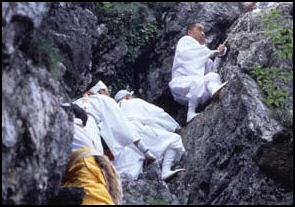
Masahira Ueno wrote in Yomiuri Shimbun: Walking through the dense forest on the route, many people performing ascetic practice sense the deities living in such vast nature. They are sometimes met by caves, huge trees that would need more than 10 people to encircle them, and round, taller-than-human rocks inscribed with Sanskrit characters. Each time, the group blows on the shell horn to purify the places and chant Hannya Shinkyo, the Heart Sutra.
In 2009, Shuichi Sakamoto was appointed as a guide to lead the Kumano Shugen group’s walk. The role is very important, as guides in ancient times are said to have been assigned to lead reigning emperors and former emperors when they visited Kumano. “I was very happy, because I felt like I was being allowed to be part of a history that dates back 1,000 years,” Sakamoto said. Sakamoto has had to safely guide groups of more than 200 people, including people who are not part of Kumano Shugen. He always remains cautious and considerate. “I always tell myself that I should be humble toward nature,” Sakamoto said.
“The Kumano Omine Okugake route connects the three Kumano Sanzan shrines in Wakayama Prefecture, including Kumano Hongu Taisha, with Mt. Yoshino in Nara Prefecture.Reaching the highest point of a steep mountain path while guiding a group, Sakamot first sees the broad blue sky. When he looks back, he can see at a glance the distance he has covered. “I feel as if the surrounding mountains were within my reach and even the Kumano Nada sea, though I can’t see it,” Sakamoto said. The legendary En no Gyoja, the supposed founder of shugendo, probably felt the same way when he traveled across the nation for his ascetic practice.
“After blowing shell horns in front of the Sho no Iwaya cave and completing their last practice of the year, Kumano Shugen’s mountain ascetics began descending a narrow mountain path and reached its foot right before sunset. Several years ago, they saw the full moon illuminating the area like daytime as soon as they reached this location on a freezing night when icicles were seen hanging from rocky areas. “This means the mountains responded to our practice,” Sakamoto said. Everyone was thinking the same, and the ascetics blew horns and recited the Heart Sutra.
Kumano Trail in Wakayama
The most famous route takes you in the footsteps of Emperors and countless others who since the Heian Period have made this same pilgrimage to Kumano Hongu Taisha Shrine. The vast shrine complex is surrounded by dark, imposing trees, towering high above the majestic roofs. Through the mists, you hear the sound of coins being dropped into wooden boxes followed by the echo of clapping as worshippers bow their heads and pray to the heavenly Gods. From here, follow the ancient route lined with small shrines and statues, to the remains of the ancient Kumano Hongu Taisha Shrine at Oyunohara, marked with an impressive torii gate and a backdrop of intense beauty.
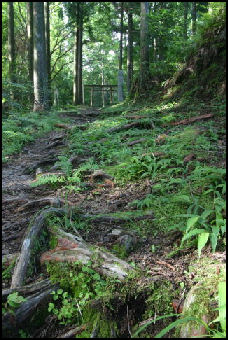 Kumano Trail in Wakayama begins in Nakaheji which can be reached by bus from the train station in the Wakayama coastal town of Tanabe. The route connects three Shinto shrines: Kumano Hongi Taisha in Hongocho, Kumano Hayatama Taisha in Shingu and Kumano Nachi Taisha in Nachikatsuuracho and two associated Buddhist temples’seigantoji and Fudarakusanji. A Canadian employee for the Tanabe City Kumano Tourism Bureau has helped make inns, restaurant hotels, towns and villages in the area accommodating to foreign tourists.
Kumano Trail in Wakayama begins in Nakaheji which can be reached by bus from the train station in the Wakayama coastal town of Tanabe. The route connects three Shinto shrines: Kumano Hongi Taisha in Hongocho, Kumano Hayatama Taisha in Shingu and Kumano Nachi Taisha in Nachikatsuuracho and two associated Buddhist temples’seigantoji and Fudarakusanji. A Canadian employee for the Tanabe City Kumano Tourism Bureau has helped make inns, restaurant hotels, towns and villages in the area accommodating to foreign tourists.
From Nakaheji it is about a three day walk to Kumano Hongu Taisha in the town of Hongu. The trail passes through some forests with tall cedar trees and other forests with groves harvested by timber companies. From Hongu the trail heads east to Kumano Naichi Taisha near the Pacific Ocean.
The route between Kumano Hongu Grand Shrine in Tanabe and Kumano Hayatama Grand Shrine in Shingu can be traversed in a 90-minute ride in a motorized wooden boat on a route through an area with cliffs and steep forested slopes. The area is often shrouded in mist. Website: Wakayama Prefecture site pref.wakayama.lg.jp
Hongu (four hours from Nara by bus) is the home of Kumano Hongu Taisha, which is reached by climbing a series of stone steps. The shrine was once located on island but after being swept away in a flood it was placed in it present located on the hill. The shrine’s torii gate, built in 2000, is the largest torii gate in Japan. It is situated in the place where the original shrine stood. The towns is nothing special. White water trips are done here on the Kumano River outside of the town. Website: Hongu Kumano Kodo hongu.jp
Onsens Near the Kumano Trail in Wakayama
You spend the night at one of the nearby Onsen (hot spring resort), choosing from the three most famous: Yunomine, Wataze or Kawayu. Here, you relax in steaming open-air baths, the steam rising over the mistcovered hills as the day draws to a close. The next day, you wake early and catch the bus or taxi up to Hosshimmon-oji Shrine midway along the ancient Nakahechi Trail from where, deep in the forests, you begin a three-hour walk back down to Kumano Hongu Taisha Shrine.
Yunomine Onsen (near Hongu) is a charming village with a number of hot springs along the river. Visitors can bath in hot-spring-fed baths inside the hotels, ryokan and minshinku that line the river or bath for free in hot springs set beside the river. One hot spring offers eggs cooked in hot spring water. The water in the river is shallow cool and clear and offers some swimming and cooling off opportunities.
Nearby Kawayu features hot springs that drain into the river. Baths are free and situated in the river. Bathers can go back and forth between the hot and cold water. In the winter an onsen is created in the river that can accommodate 1,000 people. Watarase is another onsen in the area. It is geared for bus tours. Website: Kumano Kodo site tb-kumano.jp
Totsukawa Onsen (about 20 miles north of Hongu) is another hot spring resort area. The are many baths. Many people say the best is Kamiya, a rustic natural bath near a mountain stream. Many of the guesthouses and hotels use hot spring water for their baths.For the a thrill you can pull yourself across a river in basket suspended from the cables of Totsukawa ya-en bridge about a mile outside the village of Totsukawa. About 16 miles north of Totsukawa Onsen is the Tanise no Tsurubashi bridge. The foot bridge is 297 meters long and is 54 meters above the Totsukawa River. Many long distance buses traveling through the area stop here for a break and give passengers enough time to cross the bridge, which is free, and come back. Website: Japan Hoppers japanhoppers.com
Typhoon Damage on the Kumano Trail
Atsushi Taketazu wrote in Yomiuri Shimbun: “In early September 2011, Typhoon No. 12 struck the Kii Peninsula, causing a huge amount of damage. Three Shinto shrines and ancient pilgrimage roads designated as UNESCO World Heritage sites were not spared the typhoon’s wrath, but efforts to repair them are under way. Kumano Hongu Taisha shrine, Kumano Hayatama Taisha shrine and Kumano Nachi Taisha shrine in Wakayama Prefecture, along with ancient roads that connect the shrines — known as Kumano Kodo — are part of a heritage site known as the "Sacred Sites and Pilgrimage Routes in the Kii Mountain Range." [Source: Atsushi Taketazu, Yomiuri Shimbun, November 5, 2011]
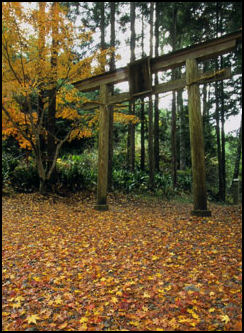
“Soon after the typhoon hit the peninsula, the grounds of Kumano Nachi Taisha shrine in Nachi-Katsuuracho were flooded by a muddy torrent. The typhoon triggered a landslide on a hill behind the shrine, leaving the main building surrounded by dirt and rocks. Hearing the news, priests from various shrines in the Kinki region headed for the shrine to remove the dirt and rocks manually. Workers with power shovels have now replaced the priests, as removal work goes on at the shrine.
“Kumano Hayatama Taisha shrine in Shingu was preparing for an annual grand festival when the typhoon hit. Floodwaters from the Kumanogawa river swept away an otabisho — a structure in which a portable shrine is temporarily enshrined during a festival. Although priests at the shrine considered reducing the scale of the grand festival, in the end they decided to go ahead and hold it as usual. "It is precisely because of the typhoon that we need to now pray for the souls of the victims and for recovery," one said.
“So after hastily setting up a makeshift otabisho, the shrine successfully held the annual festival on October 15 and 16. The typhoon also severed Kumano Kodo — a set of pilgrimage roads that run through the Kii Mountain Range and connect the shrines — in several places. Local governments are now discussing rebuilding the roads and creating detours to bypass the damaged areas. Yoshihide Asahi, 78, chief priest of the Kumano Nachi Taisha shrine, said: "People head for places where gods dwell to express their gratitude. It is our hope that the roads, which guide people to places of prayer, will be restored as soon as possible."
Image Sources: 1) 8) Kumano Kodo site 2) 5) JNTO 3) 4) Wikipedia 6) 7) 9) 15) Wakayama Prefecture site 8) Kumano Kodo 10) 11) 12) Hongu Kumnao site 14) Wikitravel
Text Sources: JNTO (Japan National Tourist Organization), Japan.org, Japan News, Japan Times, Yomiuri Shimbun, Japan Ministry of the Environment, UNESCO, Japan Guide website, Lonely Planet guides, New York Times, Washington Post, Los Angeles Times, National Geographic, The New Yorker, Bloomberg, Reuters, Associated Press, AFP, Compton's Encyclopedia and various books and other publications.
Updated in January 2023
